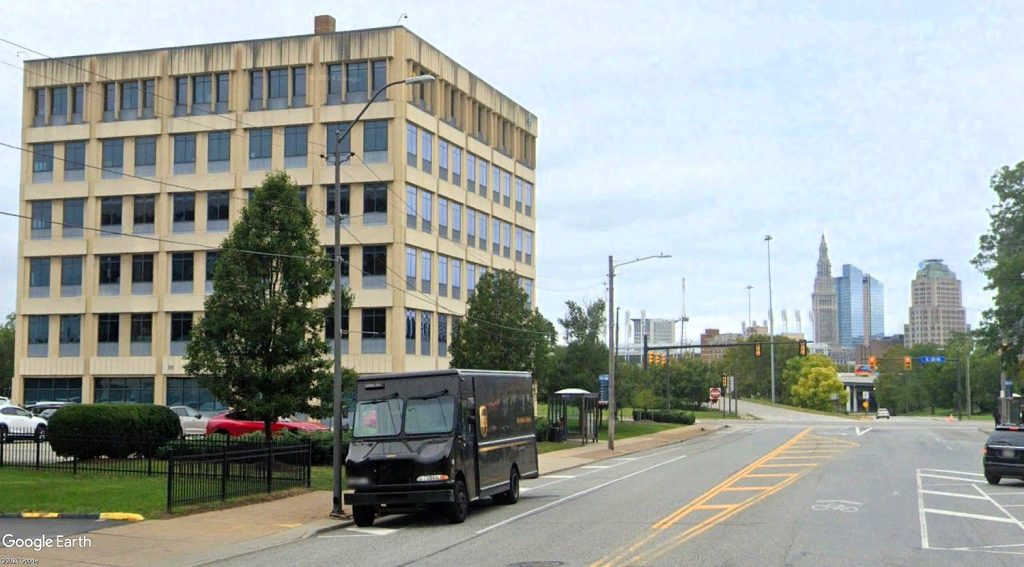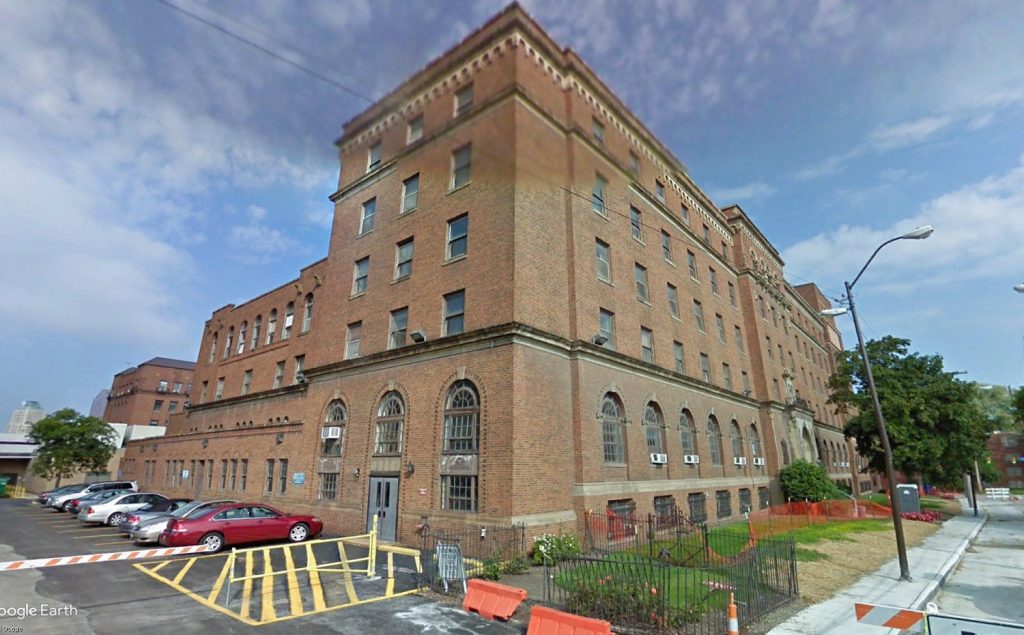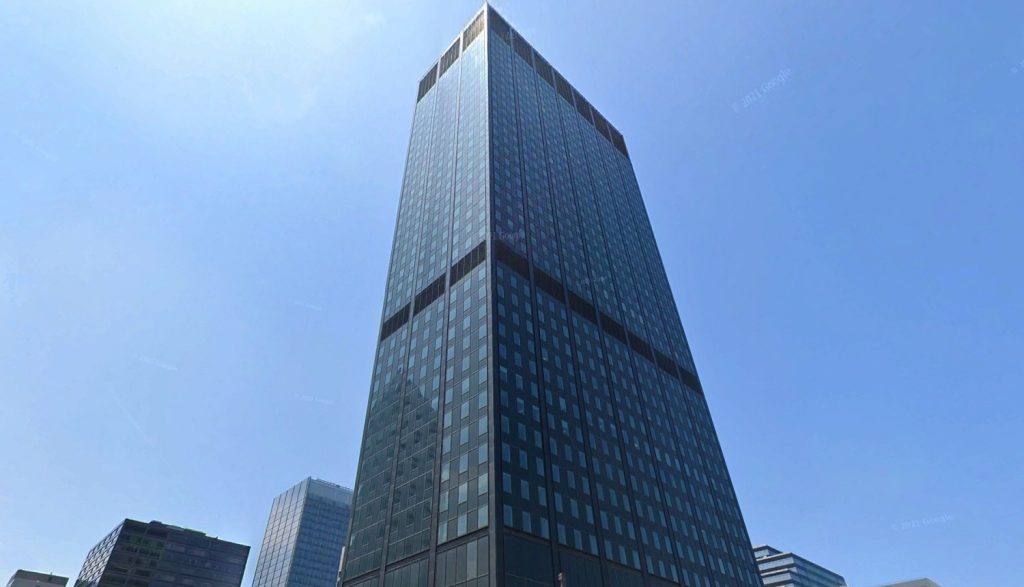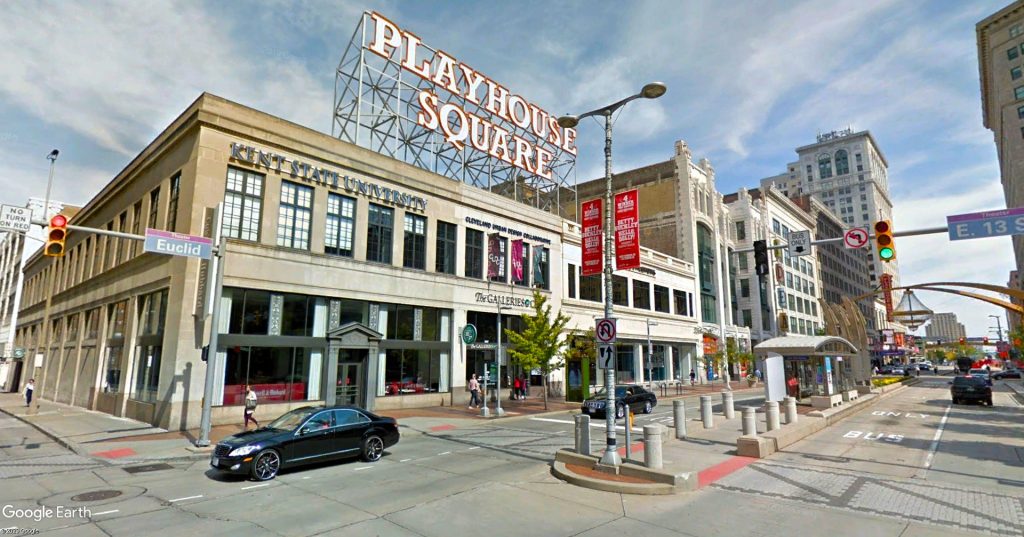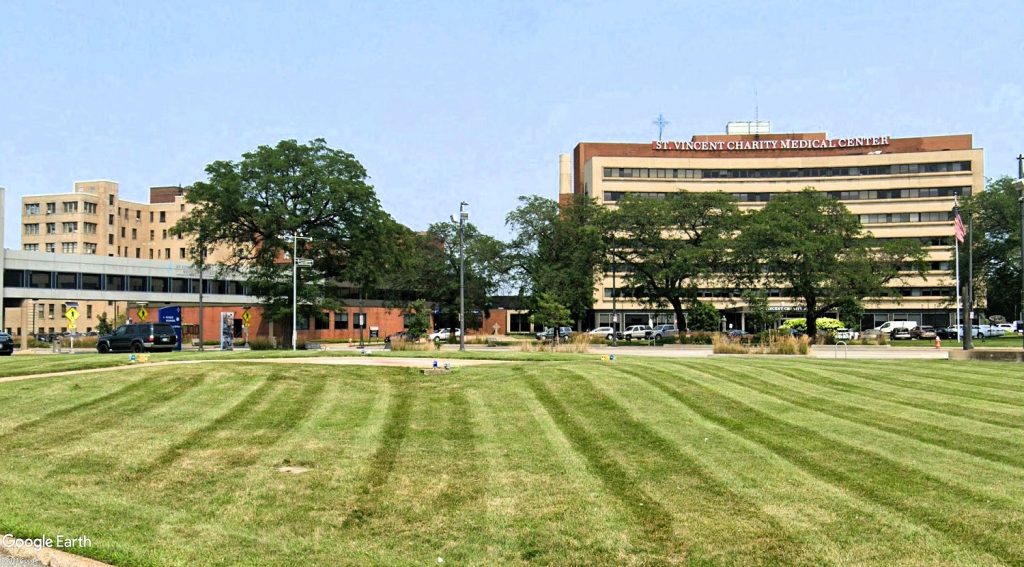
The greenfield foreground is the fate of the hospital in the background. This was the St. Vincent Charity Medical Center in 2021 — its last full year of operation. The hospital ended its in-patient services later the following year. Every structure visible here except the enclosed walkway at left and the small, one-story brick building at the end of it will be demolished in early 2025 (Google). CLICK IMAGES TO ENLARGE THEM.
Health & Healing Hub vision still coming into focus
Turns out there is more to the story that NEOtrans broke over the weekend — that St. Vincent Charity Community Health Center (SVCCHC) main campus, 2351 E. 22nd St., at the west end of Cleveland’s Central neighborhood, will be demolished in the coming months.
NEOtrans has also learned that several stakeholders in the west end of Cleveland Central neighborhood are getting ready to start masterplan efforts that will geographically intersect in the vicinity of the shuttered hospital. With those plans yet to begin, it leads to a question — why is the hospital being demolished now?
One of those stakeholders is the hospital itself and the Sisters of Charity Health System (SCHS) which oversees it. Health care system officials are considering what may replace the to-be-demolished hospital campus that closed in 2022 after 157 years of inpatient services.
Others looking to the future are City Councilman Richard Starr who is leading a masterplan of all of Ward 5, especially the Central Avenue corridor, according to a source who spoke to NEOtrans on the condition of anonymity. This will update a 2007 masterplan for Central.
The source said another masterplan that’s about to get underway is for the Campus District in the area between East 18th and East 30th streets, from the lake to the river. NEOtrans reached out to Starr and to Campus District Executive Director Mark Lammon for comment but has yet to hear from either prior to publication of this article.
City planners, on the other hand, are well aware that many things are in motion in this area. That includes the impending reconstruction of East 22nd’s bridge over the Inner Belt to create a more seamless linkage between downtown and the western part of Central.
“We are working from the planning side of things on larger planning coordination in this area because there’s so many institutional partners,” said City Planning Director Joyce Pan Huang at a Nov. 1 planning commission meeting. “(There’s) so much potential here to reconnect Central to Downtown and Downtown to Central.”
The Sisters of Charity Health System said in a press release issued yesterday that they plan to work with collaborators and partners to develop a Health and Healing Hub amid demolition plans for the hospital. But that work will start by tearing down the hospital campus whose buildings date from the 1930s to the 1980s.

So far, the only new construction envisioned in the Health and Healing Hub by the Sisters of Charity is the Women Religious Archives Collaborative Heritage Center, to be located on East 22nd Street. Construction could start as soon as March 2025. This will be the first of only four such heritage centers nationwide (Bostwick).
“Environmental remediation has begun, with the demolition expected to start in the first quarter of 2025,” said Mary Rose Sullivan, SCHS executive director of marketing and communications, in an e-mail to NEOtrans.
After NEOtrans’ article went viral over the weekend, many asked on social media and on discussion boards why couldn’t some of the hospital campus buildings be renovated and adaptive for use as quality, affordable housing, which is increasingly in short supply in Cleveland. The city has some of the fastest rising rents in the nation.
“Proceeding with demolition of the facilities comes after extensive evaluation,” Sullivan added. “It was determined that, because of the high maintenance costs of the aging facilities, an adaptive reuse is not financially feasible or sustainable.”
Members of the Sisters of Charity are also aging and not able to replace their declining ranks with younger aspirants. Such decline is also common through the eight-county Catholic Diocese of Cleveland as well as other major cities’ dioceses.
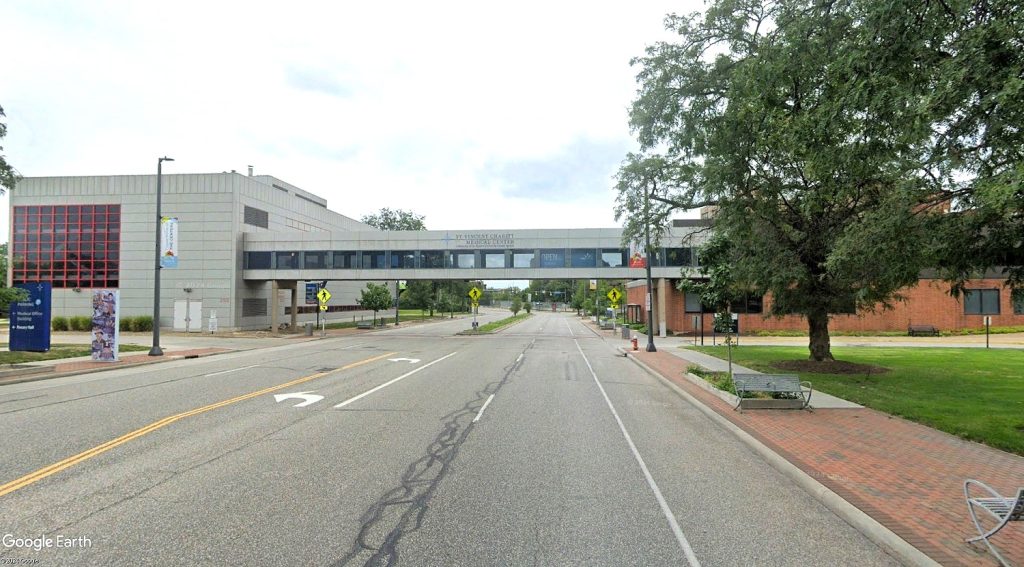
The Centers For Families And Children has acquired and will renovate the former medical office building at left for its headquarters and behavioral health care facility. It is connected to the brick ambulatory care center at right, which may become a new Neighborhood Family Practice branch. It will be the lone surviving structure after the rest of the St. Vincent Charity Medical Center is demolished (Google).
Pursuit of a Health and Healing Hub follows earlier efforts, going back to 2021, to pursue a hospital expansion masterplan. Even before that, three historic hospital buildings were demolished in the 2010s for a $35 million surgery pavilion that was never built. That project was expected to create 1,248 jobs and retain 1,200 positions,
“This marks a pivotal step toward developing a future vision of a Health and Healing Hub that will continue the cherished mission and ministry of the Sisters of Charity of St. Augustine in Cleveland’s Central Neighborhood,” Sullivan added.
Part of that includes The Centers For Families And Children, dubbed The Centers, buying the SCHS Medical Office Building just west of and across East 22nd from SVCCHC. It will serve as The Centers new headquarters and provide behavioral health services to clients. The Centers will rehab this building starting in 2025 and move into the space in 2026.
In March The Centers bought the 58,000-square-foot, 1984-built building and its 4.8-acre lot for $1.9 million. It originally sought to renovate its existing headquarters at 4500 Euclid Ave. for $10.8 million but discovered the East 22nd building could be bought and renovated for half as much money.
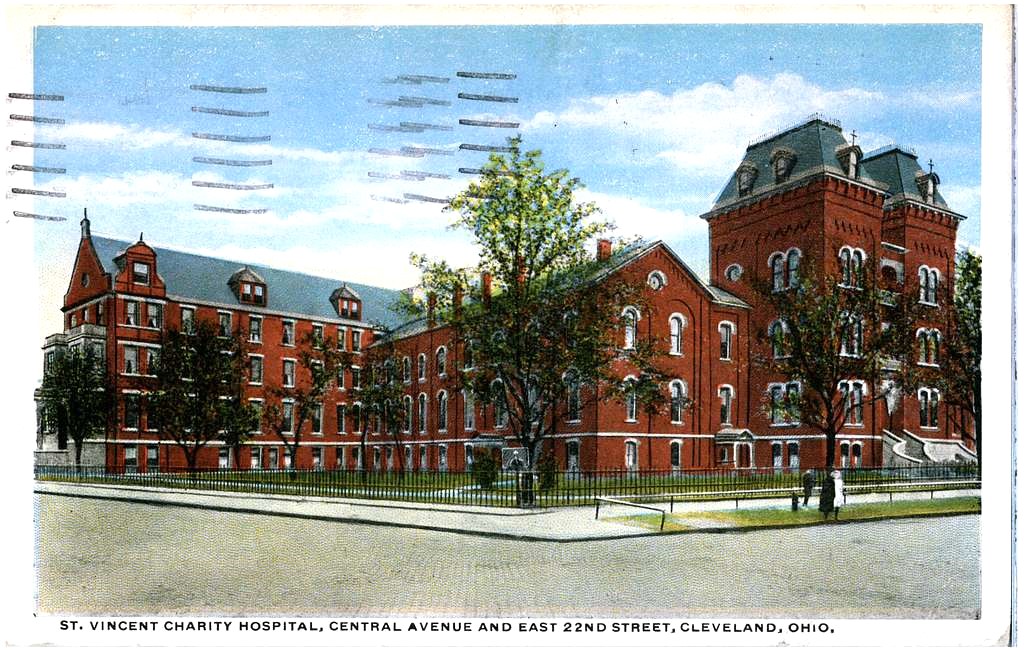
How old is St. Vincent Charity Hospital? A century ago, some of the hospital’s original buildings were starting to get worn out and overcrowded. So a campaign got underway in the 1920s to begin replacing these structures with larger, more modern buildings. Four new buildings were constructed from 1927-31. That campaign concluded with the curving hospital building that was completed in 1964 (NEOtrans collection).
Their new home is connected by an enclosed walkway over East 22nd to the only building that will survive the demolition of the SVCCHC campus. The roughly 18,000-square-foot, mostly windowless brick structure is called the HCC Building and was built as an ambulatory care center.
“My understanding is that St. V’s is working with another nonprofit on a plan to use the (HCC) Building after the demolition,” said The Centers President and CEO Eric Morse in an e-mail to NEOtrans. “The building we purchased was not owned by St. V’s; it was owned by a REIT (real estate investment trust).”
That might involve the Neighborhood Family Practice which is seeking a new Federally Qualified Health Center (FQHC) site in Cleveland’s Central Neighborhood. Sullivan said it is planned for a “property on East 22nd Street,” but gave no further details. NFP is expanding its service locations, including a new site in Clark-Fulton.
“Additional information will be provided when the agreement is finalized,” Sullivan said.
Another feature in this emerging Health and Healing Hub is a Women Religious Archives Collaborative (WRAC) Heritage Center, proposed to be constructed at 2490 E. 22nd. The $13-million, 30,000-square-foot center, the first of its kind in the nation, is due to rise starting in March 2025 on 1.5 acres of abandoned parking lot.
Next, a SCHS ministry, Joseph & Mary’s Home, Cleveland’s only provider of post-hospital medical respite care for people experiencing homelessness, has launched a campaign called “A New Home for Healing.” It seeks to renovate and relocate its facility for men, located just east of the SCHS building, 2475 E. 22nd. The project is scheduled to be completed next summer.
Speaking of the SCHS Building, the health system’s pharmacy has relocated to it from across the street at the to-be-demolished hospital. So has Outpatient Behavioral Health and Rosary Hall, which provides addiction treatment, will continue. Rosary Hall was located in the building that will now be home to The Centers.
The work of Mission Kitchen, which provides hot meals, canned goods and fresh produce to residents of Central, will continue biweekly at the William Patrick Day Head Start building, 2421 Community College Avenue, through an agreement with Cuyahoga County.
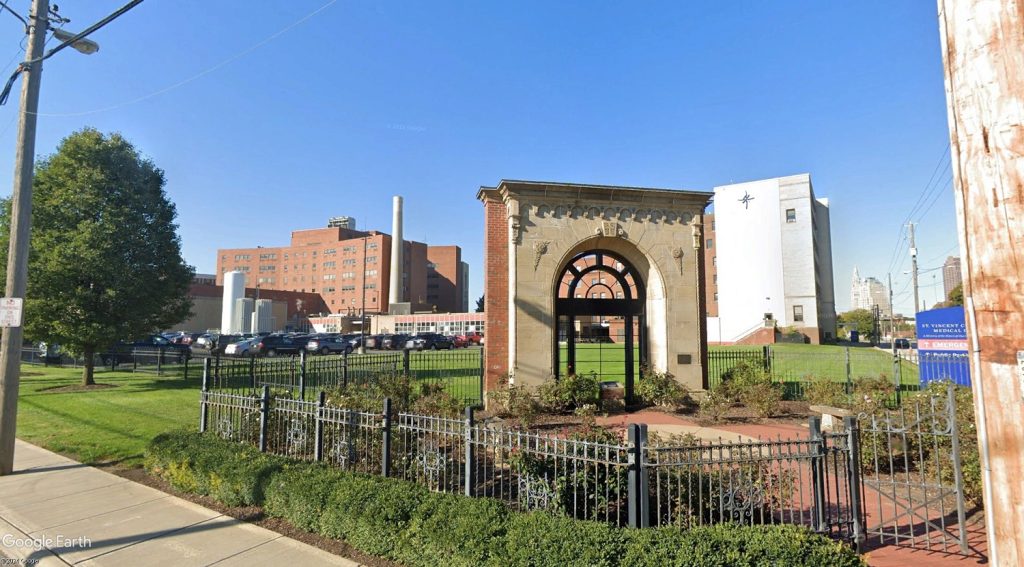
The Nurses Home’s decorative arched doorway was preserved and adorns this rose garden at East 24th and Central Avenue. Despite the demolition of St. Vincent Charity Medical Center, seen in the background, this garden will be preserved, according to demolition plans submitted to the city last week (Google).
Lastly, SCHS will continue its support and funding of Cleveland Central Promise Neighborhood, Sullivan said. This is a collective impact initiative which fosters community leadership and innovation in Central.
NEOtrans reported over the weekend that all but about 18,000 square feet of the 449,338-square-foot hospital campus will be demolished. That will leave an 8.3-acre greenfield immediately southeast of Downtown Cleveland. That’s just the start of it.
Across Central Avenue, the vacant, 1931-built Cuyahoga County Juvenile Justice Center, 2163 Cedar Ave., is to be demolished soon. Once cleared, its 4.5-acre site will be used for two years by the Ohio Department of Transportation for the $250 million reconstruction of the Central Interchange of Interstates 90 and 77.
After that, the vacated former Juvenile Justice Center site may figure into what may be the largest housing development in or near downtown. The Cuyahoga Metropolitan Housing Authority (CMHA) is seeking to replace its 87-year-old, 18-acre Olde Cedar housing projects, 2202 E. 30th St. — yet another pending demolition.
END

